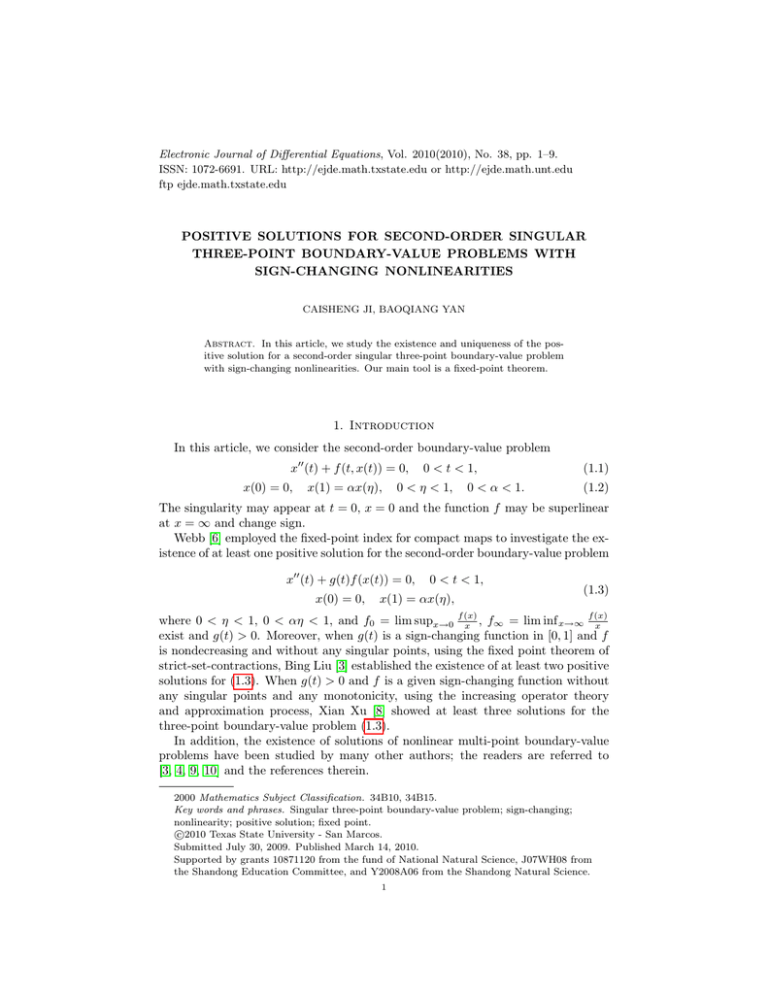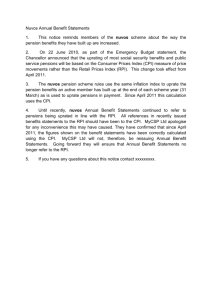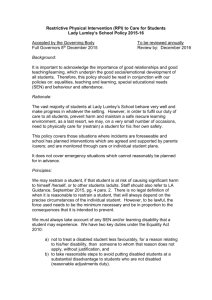Electronic Journal of Differential Equations, Vol. 2010(2010), No. 38, pp.... ISSN: 1072-6691. URL: or
advertisement

Electronic Journal of Differential Equations, Vol. 2010(2010), No. 38, pp. 1–9.
ISSN: 1072-6691. URL: http://ejde.math.txstate.edu or http://ejde.math.unt.edu
ftp ejde.math.txstate.edu
POSITIVE SOLUTIONS FOR SECOND-ORDER SINGULAR
THREE-POINT BOUNDARY-VALUE PROBLEMS WITH
SIGN-CHANGING NONLINEARITIES
CAISHENG JI, BAOQIANG YAN
Abstract. In this article, we study the existence and uniqueness of the positive solution for a second-order singular three-point boundary-value problem
with sign-changing nonlinearities. Our main tool is a fixed-point theorem.
1. Introduction
In this article, we consider the second-order boundary-value problem
x00 (t) + f (t, x(t)) = 0,
x(0) = 0,
x(1) = αx(η),
0 < t < 1,
0 < η < 1,
0 < α < 1.
(1.1)
(1.2)
The singularity may appear at t = 0, x = 0 and the function f may be superlinear
at x = ∞ and change sign.
Webb [6] employed the fixed-point index for compact maps to investigate the existence of at least one positive solution for the second-order boundary-value problem
x00 (t) + g(t)f (x(t)) = 0,
x(0) = 0,
0 < t < 1,
x(1) = αx(η),
(1.3)
f (x)
where 0 < η < 1, 0 < αη < 1, and f0 = lim supx→0 f (x)
x , f∞ = lim inf x→∞ x
exist and g(t) > 0. Moreover, when g(t) is a sign-changing function in [0, 1] and f
is nondecreasing and without any singular points, using the fixed point theorem of
strict-set-contractions, Bing Liu [3] established the existence of at least two positive
solutions for (1.3). When g(t) > 0 and f is a given sign-changing function without
any singular points and any monotonicity, using the increasing operator theory
and approximation process, Xian Xu [8] showed at least three solutions for the
three-point boundary-value problem (1.3).
In addition, the existence of solutions of nonlinear multi-point boundary-value
problems have been studied by many other authors; the readers are referred to
[3, 4, 9, 10] and the references therein.
2000 Mathematics Subject Classification. 34B10, 34B15.
Key words and phrases. Singular three-point boundary-value problem; sign-changing;
nonlinearity; positive solution; fixed point.
c
2010
Texas State University - San Marcos.
Submitted July 30, 2009. Published March 14, 2010.
Supported by grants 10871120 from the fund of National Natural Science, J07WH08 from
the Shandong Education Committee, and Y2008A06 from the Shandong Natural Science.
1
2
C. JI, B. YAN
EJDE-2010/38
Motivated by [2, 12], the purpose of this article is to examine the existence and
the uniqueness of the positive solution of (1.1)-(1.2) under the assumption that f
may be singular at t = 0, x = 0 and be superlinear at x = ∞ and change sign.
There are only a few papers considering (1.1)-(1.2) under this assumptions. We try
to fill this gap in the literature with this paper.
In this article, we use the following assumptions:
(H1) f (t, x) ∈ C((0, 1] × (0, +∞), (−∞, +∞)),
(H2) k(t), a(t), b(t) ∈ C((0, 1], (0, +∞)), tk(t) ∈ L(0, 1],
(H3) there exist F (x) ∈ C((0, +∞), (0, +∞)), G(x) ∈ C([0, +∞), [0, +∞)) such
that f (t, x) ≤ k(t)(F (x) + G(x)).
(S1) f (t, x) ≥ a(t) hold for 0 < x < b(t), x ∈ C[0, 1],
(S2) F (x) is decreasing in (0, +∞),
R1
RR
Ḡ(R) −1
> 0 sk(s)ds, where
(S3) there exist R > 1, such that 1 Fdy
(y) · (1 + F (R) )
Ḡ(R) = maxs∈[0,R] G(s).
This paper is organized as follows. In Section 2, we give some preliminaries. In
Section 3, we obtain the existence of at least one positive solution for (1.1)-(1.2),
and show an application of our results.
2. Preliminaries
Lemma 2.1 ([1]). Let E be a Banach space, R > 0, BR = {x ∈ E : kxk ≤ R},
F : BR → E be a completely continuous operator. If x 6= λF (x) for any x ∈ E with
kxk = R and 0 < λ < 1, then F has a fixed point in BR .
Let n > [ η1 + 1] be a natural number, dn = min{b(t) : t ∈ [ n1 , 1]}, bn =
min{dn , n1 }, Cn = {x : x ∈ C[ n1 , 1]} with norm kxk = max{|x(t)|, n1 ≤ t ≤ 1}.
It is easy to see that (Cn , k · k) is a Banach space.
Inspired by [12], we define Tn as
Z 1
1
(Tn x)(t) = bn +
G n1 ,1 (t, s)f (s, max{bn , x(s)})ds, x ∈ Cn , t ∈ [ , 1],
1
n
n
where
(
G1 (t, s),
G n1 ,1 (t, s) =
G2 (t, s),
(
G1 (t, s) =
1
1
1−αη−(1−α) n
1
1
1−αη−(1−α) n
G2 (t, s) =
1
n
1
n
< η ≤ s,
≤ s ≤ η,
(1 − s)(t − n1 ),
1
n
1
n)
≤ t ≤ s ≤ 1,
1
n )],
[α(t − s)(η −
− (t − 1)(s −
η ≤ s ≤ t ≤ 1,
1
1
n)
(1−αη)(t− n )−s(1−α)(t−
, 1 ≤ t ≤ s ≤ 1,
1
1−αη−(1−α) n
1
1
n)
(1−αη)(s− n )−t(1−α)(s−
,
1
1−αη−(1−α) n
n
1
n
≤ s ≤ t ≤ 1,
and G n1 ,1 (t, s) is Green’s function to the boundary-value problem
x00 (t) = 0,
1
< t < 1,
n
1
x( ) = 0, x(1) = αx(η), 0 < α < 1, 0 < η < 1.
n
By a standard argument we have the following result; see for example [7].
EJDE-2010/38
POSITIVE SOLUTIONS
3
Lemma 2.2. The operator Tn is completely continuous from Cn to Cn .
Lemma 2.3. There exist xn ∈ Cn , bn ≤ xn (t) ≤ R for t ∈ [ n1 , 1] such that
Z 1
1
G n1 ,1 (t, s)f (s, xn (s))ds, t ∈ [ , 1].
xn (t) = bn +
1
n
n
(2.1)
Proof. We prove that
1
Z
x(t) 6= λ(Tn x)(t) = λbn + λ
1
n
1
t ∈ [ , 1], (2.2)
n
G n1 ,1 (t, s)f (s, max{bn , x(s)})ds,
for any kxk = R and λ ∈ (0, 1). In fact, if (2.2) is not true, there exist x ∈ Cn with
kxk = R and 0 < λ < 1 such that
Z 1
1
x(t) = λ(Tn x)(t) = λbn + λ
G n1 ,1 (t, s)f (s, max{bn , x(s)})ds, t ∈ [ , 1]. (2.3)
1
n
n
It is easy to see that x( n1 ) = λbn , x(1) − αx(η) = (1 − α)λbn .
We first claim that x(t) ≥ λbn for any t ∈ [ n1 , 1]. In fact if x(η) < λbn , we have
x(1) = λbn +αx(η)−αλbn < λbn and x(η) < x(1). Since x( n1 ) = λbn > x(1), we can
get a point t1 ∈ ( n1 , η) such that x(t1 ) = x(1). Let γ = sup{t1 : t1 ∈ ( n1 , η), x(t1 ) =
x(1)}. It follows that x(γ) = x(1) and x(t) < x(γ) = x(1), t ∈ (γ, η). Since
x(η) < x(1) < λbn , we have two cases:
Case (1). There exist t01 ∈ (η, 1) such that x(1) ≤ x(t01 ). and
Case (2). x(t) < x(1) for all t ∈ (η, 1).
In case (1), we may get a point t2 ∈ (η, t01 ) such that x(t2 ) = x(1). Setting
β = inf{t2 : t2 ∈ (η, 1), x(t2 ) = x(1)}, we get x(β) = x(1) and x(t) < x(β) =
x(1), t ∈ (η, β). In case (2), setting β = 1, we also get x(β) = x(1) and x(t) <
x(β) = x(1), t ∈ (η, β). Hence, there exist an interval [γ, β] ⊆ ( n1 , 1](γ < β) such
that
x(γ) = x(β) < λbn , x(t) < x(γ), x(t) < x(β), t ∈ (γ, β).
(2.4)
By (2.3) and (S1), we have x00 (t) = −λf (t, bn ) < 0, t ∈ [γ, β] and x(t) is concave
down on [γ, β], which contradicts (2.4). Hence x(η) ≥ λbn , and then x(1) ≥
0
0
λbn , x(1) ≤ x(η). If there exist t2 ∈ ( n1 , η) such that x(t2 ) < λbn , a similar argument
as before yields an interval [γ 0 , β 0 ] ⊆ [ n1 , η](γ 0 < β 0 ), such that
x(t) < x(γ 0 ),
x(t) < x(β 0 ),
t ∈ (γ 0 , β 0 ),
00
x(γ 0 ) ≤ λbn ,
x(β 0 ) ≤ λbn .
0
(2.5)
0
It follows from (2.3) and (S1) that x (t) = −λf (t, bn ) < 0, t ∈ [γ , β ] and x(t) is
concave down on [γ 0 , β 0 ], which contradicts (2.5). So we have x(t) ≥ λbn , t ∈ [ n1 , η].
By the same argument used for t ∈ [ n1 , η], we can easily show that x(t) ≥ λbn , t ∈
[η, 1].
Next we claim that: for any z ∈ ( n1 , 1), if bn < x(z) < R, we have
Z x(z)
Z Z
dx
Ḡ(R) z 1
≤ 1+
k(s) ds dt.
(2.6)
F (x)
F (R) 0 t
bn
Since x( n1 ) = λbn < R, x(1) ≤ x(η), there exist t∗ ∈ ( n1 , 1) such that x(t∗ ) = R,
x0 (t∗ ) = 0. Setting t0 = inf{t∗ : t∗ ∈ ( n1 , 1), x0 (t∗ ) = 0, x(t∗ ) = kxk = R}, we obtain
t0 ∈ ( n1 , 1), x0 (t0 ) = 0, x(t0 ) = kxk = R. Obviously there exist t00 ∈ ( n1 , t0 ) such that
x(t00 ) = bn . Furthermore we get a countable set {ti } of ( n1 , 1) such that
(1) t00 = t1 < t2 ≤ t3 < t4 ≤ t5 < . . . ≤ t2m−1 < t2m ≤ . . . < 1, t2m → t0 ,
4
C. JI, B. YAN
EJDE-2010/38
(2) x(t1 ) = bn , x(t2i ) = x(t2i+1 ), x0 (t2i ) = 0, i = 1, 2, 3 . . .,
(3) x(t) is strictly increasing in [t2i−1 , t2i ], i = 1, 2, 3 . . . (if x(t) is strictly
increasing in [t00 , t0 ], put m = 1; i.e, [t1 , t2 ] = [t00 , t0 ]).
Differentiating (2.3) and using the assumptions, we obtain easily
−x00 (t) = λf (t, x(t)) ≤ λk(t)(F (x(t)) + G(x(t)))
G(x(t))
)
F (x(t))
Ḡ(R)
< k(t)F (x(t))(1 +
)
F (x(t))
Ḡ(R)
≤ k(t)F (x(t))(1 +
), t ∈ [t2i−1 , t2i ), i = 1, 2, 3 . . . .
F (R)
= λk(t)F (x(t))(1 +
Integrating (2.7) from t to t2i , we have by the decreasing property of F (x),
Z t2i
Z t2i
Ḡ(R)
−
x00 (s)ds ≤ (1 +
)
k(s)F (x(s))ds
F (R) t
t
Z t2i
Ḡ(R)
)
≤ F (x(t))(1 +
k(s)ds,
F (R) t
for t ∈ [t2i−1 , t2i ), i = 1, 2, 3 . . .; that is to say
Z t2i
Ḡ(R)
0
x (t) ≤ F (x(t))(1 +
)
k(s)ds, t ∈ [t2i−1 , t2i ), i = 1, 2, 3 . . . .
F (R) t
(2.7)
(2.8)
(2.9)
It follows from (2.9) that
Ḡ(R)
x0 (t)
≤ (1 +
)
F (x(t))
F (R)
Z
t
t2i
Ḡ(R)
)
k(s)ds ≤ (1 +
F (R)
Z
1
k(s)ds,
(2.10)
t
for t ∈ [t2i−1 , t2i ), i = 1, 2, 3 . . ..
On the other hand, we can choose i0 and z 0 ∈ ( n1 , 1), z 0 ≤ z such that z 0 ∈
[t2i0 −1 , t2i0 ) and x(z 0 ) = x(z). Integrating (2.10) from t2i−1 to t2i , i = 1, 2, 3...i0 −1
and from t2i0 −1 to z 0 , we have
Z x(t2i )
Z t2i Z 1
Ḡ(R)
dx
≤ (1 +
)
k(s) ds dt, i = 1, 2, 3 . . . i0 − 1, (2.11)
F (R) t2i−1 t
x(t2i−1 ) F (x)
and
Z
x(z 0 )
x(t2i0 −1 )
dx
Ḡ(R)
≤ (1 +
)
F (x)
F (R)
Z
z0
Z
1
k(s) ds dt.
t2i0 −1
(2.12)
t
Summing (2.11) from 1 to i0 − 1, we have by (2.12) and x(t2i ) = x(t2i+1 ), that
Z x(z0 )
Z z0 Z 1
Z zZ 1
dx
Ḡ(R)
Ḡ(R)
≤ (1 +
)
k(s) ds dt ≤ (1 +
)
k(s) ds dt.
F (x)
F (R) 0 t
F (R) 0 t
bn
Since x(z) = x(z 0 ),
Z
x(z)
bn
dx
Ḡ(R)
≤ (1 +
)
F (x)
F (R)
Z
z
Z
1
k(s) ds dt;
0
t
EJDE-2010/38
POSITIVE SOLUTIONS
5
i.e, (2.6) holds. Letting z → t0 in (2.6), we have
Z R
Z t0 Z 1
dx
Ḡ(R)
≤ (1 +
)
k(s) ds dt
F (R) 0 t
bn F (x)
Z 1Z 1
Ḡ(R)
(2.13)
k(s) ds dt
≤ (1 +
)
F (R) 0 t
Z 1
Ḡ(R)
= (1 +
)
sk(s)ds.
F (R) 0
RR
Ḡ(R) R 1
The inequality above contradicts 1 Fdx
(x) > (1 + F (R) ) 0 sk(s)ds. Hence (2.2)
holds.
It follows from Lemma 2.1 and (2.2) that Tn has a fixed point xn in Cn . Using
xn and 1 in the place of x and λ in (2.2), we obtain easily bn ≤ xn (t) ≤ R, t ∈ [ n1 , 1].
The proof is complete.
Lemma 2.4. For a fixed h ∈ (0, min{ 12 , η}), suppose mn,h = min{xn (t), t ∈ [h, 1]}.
Then mh = inf{mn,h } > 0.
Proof. Since xn (t) ≥ bn > 0, we get mh ≥ 0. For any fixed natural numbers n
(n > [ η1 ] + 1), let tn ∈ [h, 1] such that xn (tn ) = min{xn (t), t ∈ [h, 1]}. If mh = 0,
there exist a countable set {ni } such that
lim xni (tni ) = 0.
(2.14)
ni →+∞
So there exist N such that xni (tni ) ≤ min{b(t), t ∈ [ h2 , 1]}, ni > N . Then we have
two cases.
Case 1. There exist nk ∈ {ni }, nk > N and t∗nk ∈ [ h2 , h] such that xnk (t∗nk ) ≥
xnk (tnk ). By the same argument in Lemma 2.3, we can get t0nk , t00nk ∈ [ h2 , 1], t0nk <
t00nk such that
h
xnk (t) ≤ min{b(t), t ∈ [ , 1]},
2
t ∈ [t0nk , t00nk ],
xnk (t) ≤ xnk (t0nk ), xnk (t) ≤ xnk (t00nk ),
x00nk (t)
= −f (t, xnk (t)) < 0,
t∈
t ∈ (t0nk , t00nk ),
(t0nk , t00nk ).
(2.15)
(2.16)
[t0nk , t00nk ],
Inequality (2.15) shows that xnk (t) is concave down in
which contradicts
(2.16).
Case 2. xni (t) < xni (tni ), t ∈ [ h2 , h] for any ni ∈ {ni }, ni > N . And so we have
lim xni (t) = 0,
ni →+∞
h
t ∈ [ , h].
2
On the other hand for any t ∈ [ h2 , h],
Z
2 t
h
xni (t) =
(t − )(h − s)f (s, xni (s))ds
h h2
2
Z h
h
2
h
(s − )(h − t)f (s, xni (s))ds + xni ( ) + xni (h)
+
h t
2
2
Z
Z h
h
2 t
h
≥ [ (t − )(h − s)a(s)ds +
(s − )(h − t)a(s)ds] > 0,
h h2
2
2
t
(2.17)
(2.18)
6
C. JI, B. YAN
EJDE-2010/38
which contradicts (2.17). The proof is complete.
3. Main Result
Theorem 3.1. If (S1)–(S3) hold, the three-point boundary-value problem (1.1)(1.2) has at least one positive solution.
Proof. For any natural numbers n ≥ [ η1 + 1], it follows from Lemma 2.3 that there
exist xn ∈ Cn , bn ≤ xn ≤ R satisfying (2.1). Now we divide the proof into three
steps.
Step 1. There exist a convergent subsequence of {xn } in (0,1]. For a natural
number k ≥ max{3, [ η1 ] + 1}, it follows from Lemma 2.4 that 0 < m k1 ≤ xn (t) ≤ R,
t ∈ [ k1 , 1] for any natural numbers n ≥ [ η1 + 1]; i.e., {xn } is uniformly bounded in
[ k1 , 1]. Since xn also satisfies
t
Z
(t − s)f (s, xn (s))ds
xn (t) = −
1
k
Z 1
Z η
t − k1
[ (1 − s)f (s, xn (s))ds − α
+
(η − s)f (s, xn (s))ds]
1
1 − αη − k1 (1 − α) k1
k
(t − k1 )(1 − α)
1
1
+ xn ( ) +
(bn − xn ( )),
k
k
1 − αη − k1 (1 − α)
1
t ∈ [ , 1],
k
we have
x0n (t)
Z
R1
t
=−
f (s, xn (s))ds +
1
k
(1 − s)f (s, xn (s))ds − α
1 − αη −
1
k
+
(1 − α)(bn − xn (t))
,
1 − αη − k1 (1 − α)
Rη
1
k
1
k (1
(η − s)f (s, xn (s))ds
− α)
1
t ∈ [ , 1].
k
Obviously
|x0n (t)| ≤
1
2R
3−η
max{|f (t, x(t))| : (t, x) ∈ [ , 1] × [m k1 , R]} +
,
1−η
k
1−η
(3.1)
for t ∈ [ k1 , 1]. It follows from inequality (3.1) that {xn } is equicontinuous in [ k1 , 1].
The Ascoli-Arzela theorem guarantees that there exists a subsequence of {xn (t)}
(k)
which converges uniformly on [ k1 , 1]. We may choose the diagonal sequence {xk (t)}
(see more details in [13]) which converges everywhere in (0, 1] and it is easy to verify
(k)
that {xk (t)} converges uniformly on any interval [c, d] ⊆ (0, 1]. Without loss of
(k)
generality, let {xk (t)} be {xn (t)} in the rest. Putting x(t) = limn→+∞ xn (t), t ∈
(0, 1], we have x(t) is continuous in (0, 1] and x(t) ≥ mh > 0, t ∈ (0, 1] by Lemma
2.4.
EJDE-2010/38
POSITIVE SOLUTIONS
7
Step 2. x(t) satisfies (1.1). Fixed t ∈ (0, 1], we may choose h ∈ (0, min{ 12 , η})
such that t ∈ (h, 1] and
Z t
(t − s)f (s, xn (s))ds
xn (t) = −
h
Z η
Z 1
t−h
(η − s)f (s, xn (s))ds]
[ (1 − s)f (s, xn (s))ds − α
1 − αη − h(1 − α) h
h
(t − h)(1 − α)
+ xn (h) +
(bn − xn (h)), t ∈ (h, 1].
1 − αη − h(1 − α)
(3.2)
Letting n → +∞ in (3.2), we have
Z t
t−h
x(t) = −
(t − s)f (s, x(s))ds +
1
−
αη
− h(1 − α)
h
Z 1
Z η
(3.3)
×
(1 − s)f (s, x(s))ds − α
(η − s)f (s, x(s))ds
+
h
h
(t − h)(1 − α)
+ x(h) +
(−x(h)),
1 − αη − h(1 − α)
t ∈ (h, 1].
Differentiating (3.3), we get the desired result.
Step 3. x(t) satisfies (1.2). Let
1
tn = inf{t : xn (t) = kxn k, x0n (t) = 0, t ∈ [ , 1]},
n
where kxn k = max n1 ≤t≤1 xn (t) ≤ R. Then
1
tn ∈ [ , 1], xn (tn ) = kxn k, x0n (tn ) = 0.
n
Using xn (t), 1 and tn in place of x(t), λ and t0 in Lemma 2.3, we obtain easily by
(2.13)
Z kxn k
Z tn Z 1
dx
Ḡ(R)
≤ (1 +
)
k(s) ds dt.
(3.4)
F (x)
F (R) 0
bn
t
It follows from (3.4) and Lemma 2.4 that 0 < a = inf{tn } ≤ 1. Fixed z ∈ (0, a),
then bn < xn (z) < kxn k ≤ R. By Lemma 2.3 we easily get
Z xn (z)
Z zZ 1
dx
Ḡ(R)
≤ (1 +
)
k(s) ds dt, z ∈ (0, a).
(3.5)
F (x)
F (R) 0 t
bn
Letting n → +∞ in (3.5) and noticing bn → 0, we have
Z x(z)
Z zZ 1
Ḡ(R)
dx
≤ (1 +
)
k(s) ds dt,
F (x)
F (R) 0 t
0
z ∈ (0, a).
(3.6)
It follows from (3.6) that x(0) = limz→0+ x(z) = 0. Using 1 in place of λ in (2.3),
we obtain easily
xn (1) = αxn (η) + (1 − α)bn .
(3.7)
Letting n → +∞, we have x(1) = αx(η). This complete the proof.
When G(x) ≡ 0 in (H3), it is easy to see that the assumption (S3) is satisfied by
the decreasing property of F (x). Then under the assumption G(x) ≡ 0 we get the
following corollaries to Theorem 3.1.
8
C. JI, B. YAN
EJDE-2010/38
Corollary 3.2. Suppose (S1), (S2) hold. Then (1.1)-(1.2) has at least one positive
solution
Corollary 3.3. Suppose the assumptions of Corollary 3.2 hold. If further f (t, ·) is
non-increasing in (0, +∞) for each t ∈ (0, 1), the solution of (1.1)-(1.2) is unique.
Proof. Suppose x1 (t) and x2 (t) are two solutions of (1.1)-(1.2). We need to prove
that x1 (t) ≡ x2 (t), t ∈ [0, 1]. Let z(t) = x1 (t) − x2 (t), t ∈ [0, 1]. It follows that
z(0) = 0, z(1) = αz(η). We first show that x1 (η) = x2 (η), which implies that
x1 (1) = x2 (1). In fact, if it is not true, without loss of generality, we can suppose
x1 (η) > x2 (η). That is to say z(η) > 0, 0 < z(1) = αz(η) < z(η). Setting
t1 = max{t ∈ (0, η), z(t) = z(1)} and t2 = min{t ∈ (η, 1), z(t) = z(1)}, we get
z(t1 ) = z(t2 ) = z(1),
z(t) = x1 (t) − x2 (t) > z(1) > 0,
t ∈ (t1 , t2 ).
Letting s(t) = z(t)−z(1), we have that s(t1 ) = s(t2 ) = 0 and s(t) > 0, t ∈ (t1 , t2 ). It
follows from (1.1) and the monotonicity of f (t, ·) that s00 (t) = z 00 (t) ≥ 0, t ∈ (t1 , t2 ).
An elementary form of the maximum principle implies s(t) ≤ 0 for all t ∈ (t1 , t2 ) and
hence a contradiction. Then, x1 (η) = x2 (η), which also yields that x1 (1) = x2 (1).
That is to say z(0) = z(η) = z(1) = 0.
We next claim that x1 (t) = x2 (t), t ∈ (0, η). In fact, if it is not true, without
loss of generality, we can get x1 (t0 ) > x2 (t0 ) for some t0 ∈ (0, η). Let t3 =
max{t ∈ (0, t0 ), z(t) = 0}, t4 = min{t ∈ (t0 , η), z(t) = 0}(note z(η) = 0)). Then
z(t3 ) = z(t4 ) = 0 and z(t) > 0, t ∈ (t3 , t4 ). Let s1 (t) = z1 (t) − z2 (t), t ∈ [t3 , t4 ].
Then s1 (t) > 0 for all t ∈ [t3 , t4 ]. On the other hand, the monotonicity of f (t, ·)
implies that s001 (t) ≥ 0, t ∈ (t3 , t4 ). An elementary form of the maximum principle
implies s1 (t) ≤ 0 for all t ∈ (t3 , t4 ) and hence a contradiction.
The same argument yields that x1 (t) = x2 (t), t ∈ (η, 1). Hence we get x1 (t) =
x2 (t), t ∈ [0, 1]. Thus the result is proved.
Example. Consider the second order singular three-point boundary-value problem
1
x3 (t)
1
1
− 5 − 2 ) = 0,
x00 (t) + (x2 (t) + 2
4
x (t)
t
t
1 1
x(0) = 0, x(1) = x( ).
3 4
1
1
Set α = 3 , η = 4 ,
f (t, x) =
1 2
1
x3
1
(x + 2 − 5 − 2 ),
4
x
t
t
k(t) =
1
,
4
0 < t < 1,
(3.8)
(3.9)
F (x) =
1
,
x2
1
t
, b(t) = .
4t2
2
It is easy to prove that f (t, x) ≤ k(t)(F (x)+G(x)) and (S1)–(S3) hold. By Theorem
3.1, the three-point boundary-value problem (3.8)-(3.9) has at least one positive
3
solution. Moreover, if f (t, x) = x21(t) − x t5(t) in (3.8), the three-point boundaryvalue problem (3.8)-(3.9) has only one positive solution by Corollaries 3.2 and 3.3.
G(x) = x2 ,
a(t) =
References
[1] K. Deimling; Nonlinear Functional Analysis, Spinger-Verlag, New York, (1985).
[2] Patrick Habets, Fabio Zanolin Upper and lower solutions for a generalized Emden-Fowler
equation, Journal of mathematical analysis and applications 181, 684-700, (1994).
EJDE-2010/38
POSITIVE SOLUTIONS
9
[3] Bing Liu Positive solutions of second-order three-point boundary-value problems with change
of sign in Banach spaces, Nonlinear Analysis 64, (2006), 1336-1355.
[4] Ruyun Ma, Donal O’Regan Nodal solutions for second-order m-point boundary-value problems with nonlinearities across several eigenvalues, Nonlinear Analysis 64, (2006), 1562-1577.
[5] Yongping Sun Optimal existence criteria for symmetric positive solutions to a three-point
boundary-value problem, Nonlinear Analysis 66, (2007), 1051-1063.
[6] J. R. L. Webb Positive solutions of some three point boundary-value problems via fixed point
index theory, Nonlinear Analysis 47, (2001), 4319-4332.
[7] J. R. L. Webb Remarks on positive solutions of some three point boundary-value problems,
Proceedings of the fourth international conference on dynamical systems and differential
equations, May 24-27, (2002), Wilimington, NC, USA.
[8] Xian Xu Three solutions for three-point boundary-value problems, Nonlinear Analysis 63,
(2005), 1053-1066.
[9] Xian Xu Multiple sign-changing solutions for some m-point boundary-value problems, Electronic Journal of Differential Equations, Vol. 2004, No. 89, pp. 1-14. ISSN: 1072-6691.
[10] Xian Xu, Jingxian Sun On sign-changing solution for some three-point boundary-value problems, Nonlinear Analysis 59, (2004), 491-505.
[11] Xian Xu, Donal O’Regan, Sun Jingxian Multiplicity results for three-point boundary-value
problems with a non-well-ordered upper and lower solution condition, Mathematical and
Computer Modelling 45, (2007), 189-200.
[12] G. C. Yang Positive solutions of singular Dirichlet Boundary value problems with signchanging nonlinearities, Computers and Mathematics with Applications 51, (2006), 14631470.
[13] G. C. Yang Positive solutions of some second order nonlinear singular differential equations,
Computers Math. Applic. 45(4/5), 605-614, (2003).
Caisheng Ji
Department of Mathematics, Shandong Normal University, Jinan 250014, China
E-mail address: jicaisheng@163.com
Baoqiang Yan
Department of Mathematics, Shandong Normal University, Jinan 250014, China
E-mail address: yanbqcn@yahoo.com








